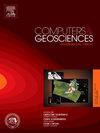构建具有孔隙度信息约束的三维数字岩石:基于双网络循环样式的深度学习方法
IF 4.2
2区 地球科学
Q1 COMPUTER SCIENCE, INTERDISCIPLINARY APPLICATIONS
引用次数: 0
摘要
要从地球物理响应中了解储层属性,就必须根据充足的岩石物理数据构建准确的岩石物理模板。然而,工程岩心取样往往受限于复杂的地下条件和高昂的成本。人工智能(AI)技术为合成数字样本提供了一种高效、经济的方法。然而,传统的深度学习方法可能会出现模式崩溃,尤其是在从有限的训练样本生成具有复杂结构的样本时。为了应对这一挑战,我们提出了新颖的生成对抗网络(GANs),以根据孔隙度分布可控地生成三维数字岩石样本。通过使用样式转移生成器,三维数字岩石的多尺度信息被集成到生成过程中,从而有效降低了模式崩溃的风险。将生成器嵌入双网循环框架,进一步增强了生成样本中条件信息的可控性。我们的分析表明,生成的样本与所需样本在孔隙率方面的最小误差仅为 0.07%。在形态参数方面观察到了明显的对比,孔隙结构的差异导致原始样品与具有相似孔隙率的合成样品之间在机械和水力特性方面存在显著差异。这表明,性能对比可能是由孔隙结构的差异而不是孔隙率造成的。这些发现将有助于今后研究孔隙结构对岩石物理特性的影响,并提高岩石物理模板在地球物理反演中的实用性。本文章由计算机程序翻译,如有差异,请以英文原文为准。
Constructing three-dimension digital rock with porosity information constraint: A double-network-cycled style-based deep-learning approach
Understanding reservoir properties from geophysical responses necessitates the construction of accurate petrophysical templates based on adequate petrophysical data. However, engineering coring is often limited by complex subsurface conditions and high costs. Artificial intelligence (AI) techniques offer an efficient and economical way to synthesize digital samples. Nevertheless, traditional deep learning approaches may suffer from mode collapse, particularly when generating samples with complex structures from a limited number of training samples. To address this challenge, we propose novel Generative Adversarial Networks (GANs) to controllably generate 3D digital rock samples according to porosity distribution. By employing a style-transfer generator, multi-scale information of 3D digital rock is integrated into the generation process, effectively reducing the risk of mode collapse. Embedding the generator into a double-network-cycled framework further enhances the controllability of conditional information in the generated samples. Our analysis shows that the minimum error between the generated samples and the desired samples in terms of porosity is only 0.07%. A clear contrast is observed in morphological parameters, and differences in pore structure lead to significant variations in mechanical and hydraulic properties between original samples and synthetic samples with similar porosity. This indicates that the property contrast is likely caused by differences in pore structures rather than porosity. These findings will assist in future studies on the effect of pore structure on petrophysical properties and improve the utility of rock physics templates in geophysical inversion.
求助全文
通过发布文献求助,成功后即可免费获取论文全文。
去求助
来源期刊

Computers & Geosciences
地学-地球科学综合
CiteScore
9.30
自引率
6.80%
发文量
164
审稿时长
3.4 months
期刊介绍:
Computers & Geosciences publishes high impact, original research at the interface between Computer Sciences and Geosciences. Publications should apply modern computer science paradigms, whether computational or informatics-based, to address problems in the geosciences.
 求助内容:
求助内容: 应助结果提醒方式:
应助结果提醒方式:


